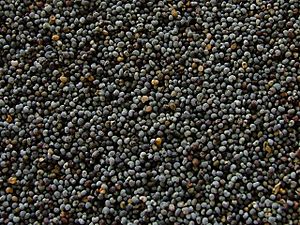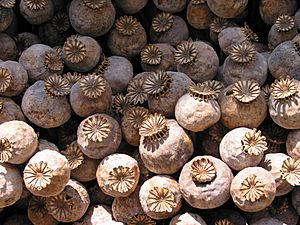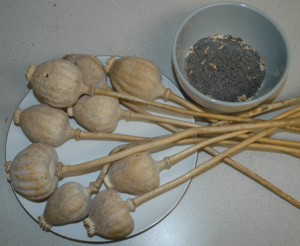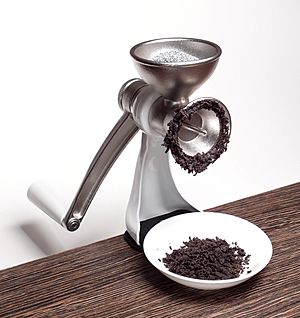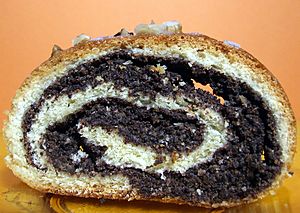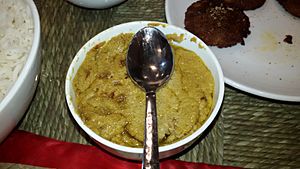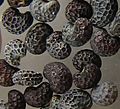Poppy seed facts for kids
Poppy seed is an oilseed obtained from the opium poppy (Papaver somniferum). The tiny, kidney-shaped seeds have been harvested from dried seed pods by various civilizations for thousands of years. It is still widely used in many countries, especially in Central Europe and South Asia, where it is legally grown and sold in shops. The seeds are used whole or ground into meal as an ingredient in many foods – especially in pastry and bread – and they are pressed to yield poppyseed oil.
Contents
History
The poppy seed is mentioned in ancient medical text from many civilizations. For instance, the Egyptian papyrus scroll named Ebers Papyrus, written c. 1550 BC, lists poppy seed as a sedative. The Minoan civilization (approximately 2700 to 1450 BC), a Bronze Age civilization which arose on the island of Crete, cultivated poppies for their seed, and used them in a mixture for calming crying babies. The Sumerians are another civilization that are known to have grown poppy seeds.
Description
Poppy seeds are less than a millimeter in length, kidney-shaped, and have a pitted surface. It takes about 3,300 poppy seeds to make up a gram, and between 1 and 2 million seeds to make up a pound. The primary flavor compound is 2-pentylfuran.
The seeds of other poppy types are not eaten, but they are cultivated for the flowers they produce. Annual and biennial poppies are considered a good choice to cultivate from seed as they are not difficult to propagate by this method, and can be put directly in the ground during January. The California poppy (Eschscholzia californica), for example, is a striking orange wildflower that grows in the Western and Northwestern United States.
Production
| Poppy seed production (tonnes) | ||
|---|---|---|
| Country | 2018 | 2014–2018 average |
| 26,991 | 21,479 | |
| 13,666 | 22,739 | |
| 12,360 | 11,812 | |
| 4,514 | 5,467 | |
| 3,800 | 6,047 | |
| Source: FAOSTAT of the United Nations | ||
In 2018, world production of poppy seeds was 76,240 tonnes, led by Turkey with 35% of the world total, followed by the Czech Republic and Spain as other major producers (table).
Since poppy seeds are relatively expensive, they are sometimes mixed with the seeds of Amaranthus paniculatus, which closely resemble poppy seeds.
Nutrition
| Nutritional value per 100 g (3.5 oz) | |
|---|---|
| Energy | 2,196 kJ (525 kcal) |
|
28.13 g
|
|
| Sugars | 2.99 g |
| Dietary fiber | 19.5 g |
|
41.56 g
|
|
| Saturated | 4.517 g |
| Monounsaturated | 5.982 g |
| Polyunsaturated | 28.569 g |
|
Protein
|
21.22 g
|
| Vitamins | Quantity
%DV†
|
| Vitamin A equiv.
beta-Carotene
lutein zeaxanthin
|
0%
0 μg0 μg
|
| Vitamin A | 0 IU |
| Thiamine (B1) |
74%
0.854 mg |
| Riboflavin (B2) |
8%
0.100 mg |
| Niacin (B3) |
6%
0.896 mg |
| Pantothenic acid (B5) |
0%
0 mg |
| Vitamin B6 |
19%
0.247 mg |
| Folate (B9) |
21%
82 μg |
| Choline |
11%
52.1 mg |
| Vitamin C |
1%
1 mg |
| Vitamin E |
12%
1.77 mg |
| Vitamin K |
0%
0.0 μg |
| Minerals | Quantity
%DV†
|
| Calcium |
144%
1438 mg |
| Copper |
0%
0 mg |
| Iron |
75%
9.76 mg |
| Magnesium |
98%
347 mg |
| Manganese |
109%
2.285 mg |
| Phosphorus |
124%
870 mg |
| Potassium |
24%
719 mg |
| Selenium |
0%
0 μg |
| Sodium |
2%
26 mg |
| Zinc |
74%
7.0 mg |
| Other constituents | Quantity |
| Water | 5.95 g |
|
Link to USDA Database entry
|
|
| †Percentages estimated using US recommendations for adults. | |
In a 100 gram amount, poppy seeds provide 525 calories and are a rich source of thiamin, folate, and several essential minerals, including calcium, iron, magnesium, manganese, phosphorus and zinc (table). Poppy seeds are composed of 6% water, 28% carbohydrates, 42% fat, and 21% protein (table).
Food products
Intact seeds
Whole poppy seeds are widely used as a spice and decoration in and on top of many baked goods and pastries. In North America they are used in and on many food items such as poppyseed muffins, rusk, bagels (like the Montreal-style bagel), bialys, and cakes such as sponge cake. Poppy seeds can also be used like sesame seeds, added to hamburger buns or to make a bar of candy. The bars are made from boiled seeds mixed with sugar or with honey. This is especially common in the Balkans, Greece and even in the cuisines of former Austro-Hungarian countries.
The color of poppy seeds is important in some uses. According to The Joy of Cooking, "the most desirable come from Holland and are a slate-blue color." When used as a thickener in some dishes, white poppy seeds are preferred, having less impact on the color of the food. In other dishes, black poppy seeds are preferred, for maximum impact. Blue poppy seeds are used in various German breads and desserts as well as in Polish cuisine.
Paste
Poppy seeds can be ground using a generic tool such as a mortar and pestle or a small domestic type electric blade grinder, or a special purpose poppy seed grinder. A poppy seed grinder (mill) is a type of burr grinder with a set aperture that is too narrow for intact poppy seeds to pass through. A burr grinder produces a more uniform and less oily paste than these other tools.
The poppy seed paste is used for fillings in pastries, sometimes mixed with butter or milk and sugar. The ground filling is used in poppy seed rolls and some croissants and may be flavored with lemon or orange zest, rum and vanilla with raisins, heavy cream, cinnamon, and chopped blanched almonds or walnuts added. For sweet baked goods, sometimes instead of sugar a tablespoon of jam, or other sweet binding agent, like syrup is substituted. The poppy seed for fillings are best when they are finely and freshly ground because this will make a big difference in the pastry filling's texture and taste.
Poppy seed paste is available commercially, in cans. Poppy seeds are very high in oil, so commercial pastes normally contain sugar, water, and an emulsifier such as soy lecithin to keep the paste from separating. Commercial pastes also contain food preservatives to keep them from becoming rancid.
In the United States, commercial pastes are marketed under brand names including Solo and American Almond. Per 30 gram serving, the American Almond poppy seed paste has 120 calories, 4.5 grams fat, and 2 grams protein.
Oil
Poppy seeds are pressed to form poppyseed oil, a valuable commercial oil that has multiple culinary and industrial uses.
Other uses
Poppy seeds are often used as bird seed, in which case they are usually called maw seeds.
Use by cuisine
Poppy seeds are used around the world in various cuisines.
European cuisine
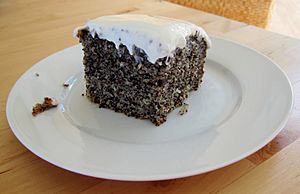
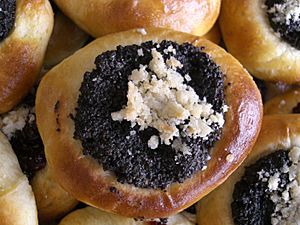
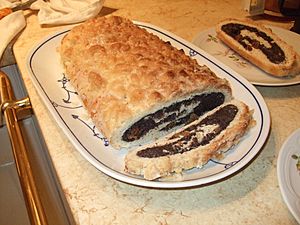
Across Europe, buns and soft white bread pastries are often sprinkled on top with black and white poppy seeds (for example cozonac, kalach, kolache and kołacz). The seeds of the Czech blue poppy (food safety cultivars Papaver somniferum) are widely consumed in many parts of Central and Eastern Europe. The sugared, milled mature seeds are eaten with pasta, or they are boiled with milk and used as filling or topping on various kinds of sweet pastry. Milling of mature seeds is carried out either industrially or at home, where it is generally done with a manual poppy seed mill.
Blue poppy seeds are widely used in Austrian, Croatian, Czech, Danish, German, Hungarian, Lithuanian, Polish, Romanian, Russian, Serbian, Slovak, Slovenian, Turkish and Ukrainian cuisines.
The states of former Yugoslavia (notably North Macedonia and Serbia, but also Croatia and Bosnia) have a long tradition of preparing poppy seed pastry (štrudla, baklava, pajgle) and dishes (pasta with poppy seeds). In Slovenia blue poppy seeds are used in traditional dishes such as prekmurska gibanica and makova potica.
In Poland, Hungary, Lithuania and Eastern Slovakia, a traditional dessert is prepared for the Kūčios (Christmas Eve) (in Hungarian: mákos guba) dinner from poppy seeds. They are ground and mixed with water or milk; round yeast biscuits (kūčiukai in Lithuanian; opekance or bobalky in Slovak) are soaked in the resulting poppy seed 'milk' (poppy milk) and served cold.
In Central Europe, poppy strudel is very popular, especially during Christmas. In Germany, Poland and countries belonging to the former Austro-Hungarian Empire, poppy seed pastries called Mohnkuchen are often eaten around Christmas time. Recipes for Mohnstriezel use poppy seed soaked in water for two hours or boiled in milk. A recipe for Ukrainian poppyseed cake recommends preparing the seeds by immersing in boiling water, straining and soaking in milk overnight.
Jewish cuisine
In Eastern European Jewish cuisine, pastries filled with black poppy seeds in a sugary paste are traditional during Purim, which occurs exactly one month before Passover and approximately a month before Easter. Traditional pastries include poppy seed kalács and hamantashen, both sometimes known as beigli (also spelled bejgli). Poppy seed hamantashen were the main traditional food eaten by Ashkenazi Jews at Purim until the filling was replaced by other fruit and nut fillings. Poppy seed pastries are common in Jewish bakeries and delicatessens throughout the United States.
Indian cuisine
In Indian cuisine, white poppy seeds are added for thickness, texture and flavor to recipes. Commonly used in the preparation of korma, ground poppy seeds, along with coconut and other spices, are combined into a paste added during cooking. Poppy seeds are widely used in many regional Indian cuisines. One dish is aloo posto (potato and poppy seeds) which consists of ground poppy seeds cooked together with potatoes and made into a smooth, rich product, which is sometimes eaten with rice. There are many variants to this basic dish, replacing or complementing the potatoes with other ingredients, such as onions (penyaj posto), pointed gourd (potol posto), Ridged Luffa (jhinge posto), chicken (murgi posto), and prawns (chingri posto). Chadachadi is a dish from Bengali cuisine and includes long strips of vegetables, sometimes with the stalks of leafy greens added, all lightly seasoned with spices like mustard or poppy seeds and flavored with a phoron. One dish involves grilling patties made from posto, sometimes frying them (postor bora). Another dish involves simply mixing uncooked ground poppy seeds (kancha posto) with mustard oil, chopped green chili peppers, fresh onions and rice. Kacha posto bata (uncooked poppy seeds paste) with mustard oil is a very popular dish in West Bengal as well as Bangladesh. Poppy seeds are widely used in Kashmir as a topping on various breads, especially kulcha.
Poppy seeds, along with tulsi (basil) seeds, are added to beverages such as thandai, sharbat, milkshakes, rose milk, almond milk and khus khus milk.
Gallery


